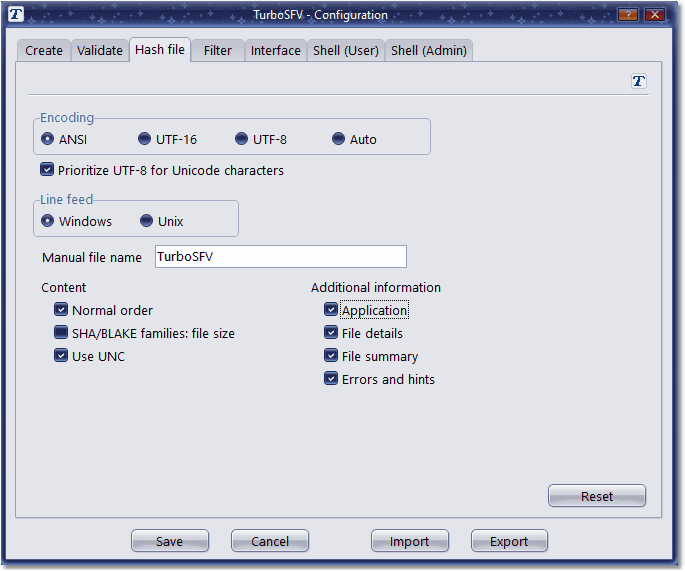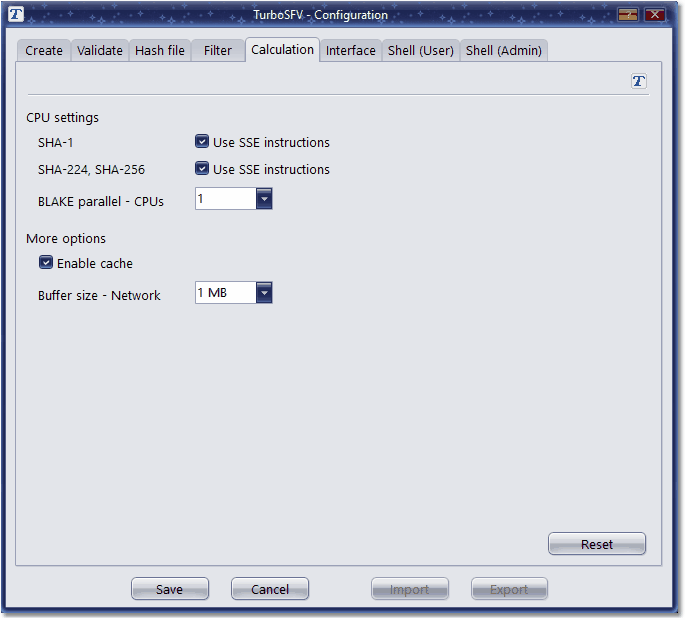| Overview |
|
In TurboSFV, various settings can be adjusted for the creation of hash files, the validation of files, the
interface and for the shell integration.
|
|
The following screenshots show the configuration dialogs for TurboSFV PE, which slightly differ for
other versions of TurboSFV, depending on their functionality.
|

|
| Options for the creation of hash files |
|
|
|
These options include settings for the checksum file creation process.
|

|
- Close Window
- Provides options for closing the window: Normal (via x-button), On click (click inside window frame),
Timer (auto-close).
- Initial directory
- This is the location where TurboSFV starts to look for folders and files to be hashed when the
main menu is used. If the option "Last folder" is checked, then the initial directory
for the dialog is the last used folder.
- Recursive scan mode
- Provides options for specifying the way, how a folder tree is scanned for files. The file order
in checksum files changes accordingly.
- File name (creation mode "Summary")
- With these options it can be specified, how the file name of the checksum file is formed and
whether or not the "Save As" dialog appears. With the option "Dialog",
a file name is suggested by TurboSFV and a dialog appears. With "Auto", the dialog
appears only if needed and with "Manual", the manual file name is used as specified
on page hash file.
- Start minimized ("Summary")
- The window, which displays the progress for the creation process, starts minimized (usually as
a button on the taskbar).
- Create a backup file ("Summary")
- If hash file exists, then the file will be renamed by adding a .bak extension. An exiting .bak
file will be automatically replaced
|

|
| Options for the validation of hash values |
|
|
|
These options include settings for the validation process.
|

|
- Skip previously checked
- Previously verified files won't be checked again.
- Days since last full check
- TurboSFV keeps track of the files which have been verified. With this setting,
the number of days before this information is removed can be adjusted.
- Allow different location
- Previously verified files can be skipped regardless of the location.
- Examine total size
- While loading the checksum file, TurboSFV can already detect missed files or
files with a changed size. The calculation progress is either based on the size
or the number of files.
- Initial directory
- This is the location where TurboSFV starts to look for folders and
files to be verified when the main menu is used. If
the option "Last folder" is checked, then the initial directory
for the dialog is the last used folder.
|

|
| Options for the checksum file |
|
|
|
These options include settings for the hash file.
|

|
- Encoding
- Defines a default encoding for the hash file. With the option Auto, the needed
encoding can be automatically detected.
- Prioritize UTF-8
- UTF-8 can take precedence over UTF-16 as the Unicode capable encoding.
- Line feed
- Specifies the characters used in the hash file to indicate a new line.
- Manual file name
- Used for the creation mode "Per folder", but also used for the creation mode
"Summary", if the option "Manual" is selected.
- Hash type as commentary line
- For some algorithms, an identifier will be saved in the hash file. along with the
checksum. By using this option, the identifier will be saved as the first commentary
line, once for all hash values. Previous versions of TurboSFV (v10.10 and older) are not
aware of this option and might fail to identify the hash type.
- Normal order
- File names together with their hash values will be saved in normal order, means
from a .. z - otherwise in reverse order.
- SHA / BLAKE families: file size
- Adds along with the hash value the file size of each file to the hash file. This
option provides additional security.
- Use UNC
- For files located on a network drive, the UNC path will be saved in the hash file instead
of the drive letter.
- Checksums: Upper-case
- Checksums will be saved in capital letters.
- Application
- Adds basic information of TurboSFV as commentary lines to the hash file: application name
and version, creation time, link to the TurboSFV homepage.
- File details
- Adds the following information as commentary lines to the hash file:
file date and time, file size, file path and name.
- File summary
- Adds the following information as commentary lines to the hash file: hash type, total
number of files, total size.
- Errors and hints
- If a file can't be hashed for any reason, then detailed information will be added to the hash file.
|

|
| Options to setup the file filter |
|
|
|
These options include general filter settings. In the current version, it's possible
to filter files by their attributes, names and extensions. This filter can be applied for the
following program modules:
|

|
- No filter
- The appropriate list won't be used to filter files.
- Include
- Files with the listed file attributes or file names / extensions will be considered, all other files not.
- Exclude
- All files will be considered, except those listed.
- List: File attributes and file names / extensions
- File attributes and file names / extensions, which shall be included or excluded.
|
|
Both filters can be used alone or together.
|

|
| Options for the calculation |
|
|
|
On this page, some generell settings for the calculation process are available.
|

|
- SHA-1: Use SSE instructions
- Instead of the normal x86/x64 CPU instructions, special SSE (Streaming SIMD Extensions) based
instructions (SHA1RNDS4, SHA1MSG1, SHA1MSG2, SHA1NEXTE)
can be used for the calculation of SHA-1 checksums, if the CPU supports them.
- SHA-256, SHA-224: Use SSE instructions
- Instead of the normal x86/x64 CPU instructions, special SSE (Streaming SIMD Extensions) based
instructions (SHA256RNDS2, SHA256MSG1, SHA256MSG2)
can be used for the calculation of SHA-256 / SHA-224 checksums, if the CPU supports them.
- BLAKE3: CPU instructions
- Along with the normal x86/x64 instructions, special SIMD (Single Instruction Multiple Data)
instruction set extensions are offered for algorithms from the BLAKE3 family (BLAKE3-256,
BLAKE3-512, BLAKE3-1024, BLAKE3-2048): SSE (Streaming SIMD Extensions), which uses XMM registers
(128 bit) and AVX2 (Advanced Vector Extensions), which are based on YMM registers (256 bit).
Unsupported CPU instruction set extensions are disabled.
- Blake parallel CPUs
- The number of CPUs to be used in case of parallel working algorithms from the BLAKE family.
- CPU - Supported SIMD features
- A list of SIMD instruction sets, used by TurboSFV, with an indication, whether a feature is
supported by the CPU. The AVX512 features are already added for future extensions. The processor
name is taken directly from the CPU and displayed as is.
- Enable cache
- This option enables the hashing of cached files and can significantly improve the speed.
- Buffer size: Network
- The size of the read buffer to be used for files located on a network device.
|

|
| Options to adjust the interface |
|
|
|
These options include settings for the appearance of TurboSFV.
|

|
- Style
- The appearance of TurboSFV can be changed by selecting one of the available styles.
The option "Windows" uses the Windows standard colors. If another style than
"Windows" is active, then the other controls on this page are displayed in the
selected style as a preview.
- Load styles
- Adds all available styles to the list of selectable styles.
- Language
- Changes the language of TurboSFV (actually English and German).
- Progress
- Changes the unit, which is used to display the total progress during the validation.
- Auto scroll
- During the validation, the file list will be automatically scrolled.
- Flash window
- Signals, that a hash job is finished.
- Taskbar animation
- The appropriate taskbar button in the taskbar is colored, representing the progress
and the state of a hash job.
- Empty clipboard
- Content in the clipboard coming from TurboSFV can be automatically removed on program close.
- Sound effects
- TurboSFV plays a sound at the end of an operation.
- Long operations only
- Sounds are only enabled for longer operations.
- Checksums: Upper-case
- Checksums will be displayed in capital letters.
- Fixed width font for validation file list
- For the display of the file list, one of the available fonts with a fixed character width
can be used.
|

|
| Options to adjust the shell integration (user level) |
|
|
|
These options include configuration options for the shell extensions of TurboSFV on user level.
|

|
- File associations
- Displays user-effective file associations. Depending on the Windows version, the appropriate
configuration dialog can be directly called from here.
- Infotip: Search new files
- The infotip can display the number of new files, which are not listed in the hash file
(if relative paths are used in the hash file).
- Infotip: Use filter
- While searching for new files, the
file filter
will be applied.
- Infotip: Search recursive
- Includes sub folders while searching for new files.
- File property page: Hash
- For smaller files, the calculation of checksums starts automatically. Here you can define the
maximum size of a small file.
- Legacy context menu: Group entries
- In the legacy context menu, menu entries can be grouped in sub menus, for example hash types
by their family.
- Windows 11 registration: Update
- Updates the registration of the Windows 11 context menu on user level.
- Hide menu: Legacy context menu
- The entire TurboSFV menu disappears from the legacy context menu.
- Hide menu: New context menu (Windows 11)
- Hides the entire TurboSFV menu in the new Windows 11 context menu. Hides also the second
menu entry in the legacy context menu, which is based on the same interface.
- Default value for hidden entries
- The listed menu entries will disappear from the menu, if "Hide" is checked.
For a hidden entry, a default value can be defined, which will be then taken.
- Main menu: Same settings
- If checked, the settings for the explorer context menu will also be applied on the TurboSFV main
menu. Otherwise all hash types will be displayed in groups and all checkboxes will be shown.
- List of hash functions
- Select one or more hash functions to be added to the explorer context menu.
|

|
| Options to adjust the shell integration (system level) |
|
|
|
These options include configuration options for the shell extensions of TurboSFV on system level.
|

|
- File associations
- Registers file extensions for TurboSFV on machine level.
- Context menu
- Adds menu entries to the context menu for shell objects: Options for the validation and the creation of hash files.
- Property page: Hash file content
- Adds a property page for all registered hash files, which displays details for the hash file.
- Property page: Hash value calculation
- Adds a property page which allows the calculation of hash values for files on the fly.
- Infotip
- Displays an infotip for all registered hash files.
|

|
| Configuration: Context sensitive help |
|
|
|
The title bar includes a question mark, which allows to get help for a specific control:
|

|
|
Configuration values can be loaded from a file with the import button, which were previously saved with the export button. The
reset button allows to set values on the current configuration page back to their default values.
|

|
| |
|
|










































